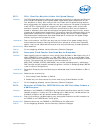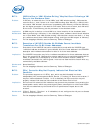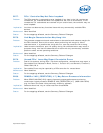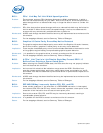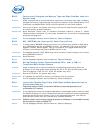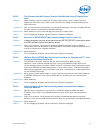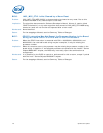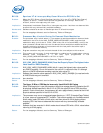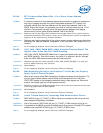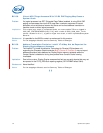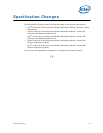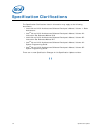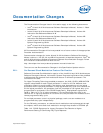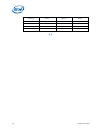
50 Specification Update
BV100. Spurious VT-d Interrupts May Occur When the PFO Bit is Set
Problem: When the PFO (Primary Fault Overflow) field (bit [0] in the VT-d FSTS [Fault Status]
register) is set to 1, further faults should not generate an interrupt. Due to this
erratum, further interrupts may still occur.
Implication: Unexpected Invalidation Queue Error interrupts may occur. Intel has not observed this
erratum with any commercially available software.
Workaround: Software should be written to handle spurious VT-d fault interrupts.
Status: For the steppings affected, see the Summary Tables of Changes.
BV101. Processor May Livelock During On Demand Clock Modulation
Problem: The processor may livelock when (1) a processor thread has enabled on demand clock
modulation via bit 4 of the IA32_CLOCK_MODULATION MSR (19AH) and the clock
modulation duty cycle is set to 12.5% (02H in bits 3:0 of the same MSR), and (2) the
other processor thread does not have on demand clock modulation enabled and that
thread is executing a stream of instructions with the lock prefix that either split a
cacheline or access UC memory.
Implication: Program execution may stall on both threads of the core subject to this erratum.
Workaround: This erratum will not occur if clock modulation is enabled on all threads when using on
demand clock modulation or if the duty cycle programmed in the
IA32_CLOCK_MODULATION MSR is 18.75% or higher.
Status: For the steppings affected, see the Summary Tables of Changes.
BV102. IA32_VMX_VMCS_ENUM MSR (48AH) Does Not Properly Report The Highest Index
Value Used For VMCS Encoding
Problem: IA32_VMX_VMCS_ENUM MSR (48AH) bits 9:1 report the highest index value used for
any VMCS encoding.
Due to this erratum, the value 21 is returned in bits 9:1 although
there is a VMCS field whose encoding uses the index value 23.
Implication: Software that uses the value reported in IA32_VMX_VMCS_ENUM[9:1] to read and write
all VMCS fields may omit one field.
Workaround: None identified.
Status: For the steppings affected, see the Summary Tables of Changes.
BV103. The Upper 32 Bits of CR3 May be Incorrectly Used With 32-Bit Paging
Problem: When 32-bit paging is in use, the processor should use a page directory located at the 32-
bit physical address specified in bits 31:12 of CR3; the upper 32 bits of CR3 should be
ignored.
Due to this erratum, the processor will use a page directory located at the 64-bit
physical address specified in bits 63:12 of CR3.
Implication: The processor may use an unexpected page directory or, if EPT (Extended Page Tables)
is in use, cause an unexpected EPT violation. This erratum applies only if software enters
64-bit mode, loads CR3 with a 64-bit value, and then returns to 32-bit paging without
changing CR3. Intel has not observed this erratum with any commercially available
software.
Workaround: Software that has executed in 64-bit mode should reload CR3 with a 32-bit value before
returning to 32-bit paging.
Status: For the steppings affected, see the Summary Tables of Changes.



